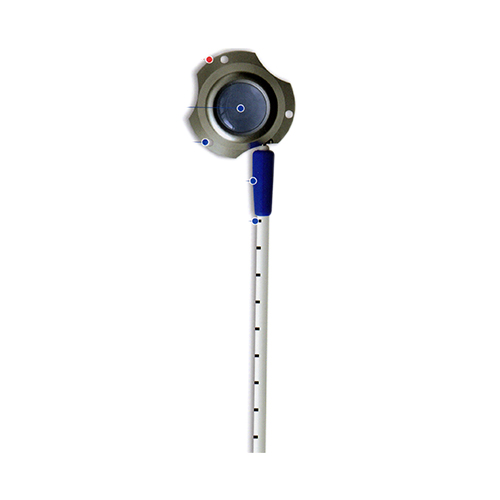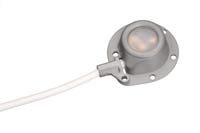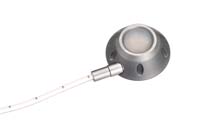
VORTEX Implantable Ports

Vortex® Ports (LP, MP, TR & VX)
AngioDynamics’ Vortex revolutionizes port design with a rounded chamber that has no sludge-harboring corners or dead spaces.
State-of the-art tangential outlets and clear-flow technology set up efficient flushing action to hyper-cleanse the entire chamber, resist sludge build up, and reduce occlusions and infections. This represents a major improvement over conventional port technology in which perpendicular outlets produce chaotic flow and inefficient flushing, and square corners that promote the formation of sludge within dead space.
Designed for extended life, Vortex ports provide better patient outcomes, fewer complications, less nursing time and lower expenses than when a conventional port is placed. Vortex models include the LP, MP, TR and VX (see below for specifications).
Vortex LP
The Vortex LP port features a line of titanium and plastic models with a choice of silicone or polyurethane catheters. Single, dual, and low profile models are available. AngioDynamics’ Vortex revolutionizes port design with a rounded chamber that has no sludge-harboring corners or dead spaces. In addition, the Vortex tangential outlet adds flushing action.
Features:
· Rounded reservoir reduces the chance of sludge buildup and helps reduce occlusions and infections
· Tangential outlet facilitates efficient flushing action to cleanse entire chamber
· 100% guarantee against sludge buildup in port reservoir
· Latex free
· Titanium: MRI conditional – 3 Tesla/Plastic: MRI Safe
· Complete size offerings – the Vortex LP is available in plastic and titanium, with single, dual, and low-profile options
· Large septum diameter – features a greater target area for ease of access
· Atraumatic tip catheter – tapered to reduce vessel trauma
· Bayonet locking mechanism
Vortex MP
Indicated for peripheral or chest placement, the Vortex MP port offers a line of low profile models featuring the largest septum diameter of any peripheral port available. AngioDynamics’ Vortex revolutionizes port design with a rounded chamber that has no sludge-harboring corners or dead spaces. In addition, the Vortex tangential outlet adds flushing action.
Features:
· 100% guarantee against sludge buildup in port reservoir
· Low profile design – the Vortex MP’s low profile design is ideal for chest or peripheral placement
· Largest septum diameter of any peripheral port – the Vortex MP features a greater target area for ease of access
· Latex Free/MRI conditional – 3 Tesla
· FluoroMax® catheter – high radiopaque tip allows for greater distinction between catheter and tip to aid in confirming ideal tip placement; marked catheters are available in polyurethane and silicone
· Snap-lock™ locking mechanism – Snap-lock allows the confirmation of a secure attachment with feel, sight, and sound of placement
· Available in 5 French size
Vortex TR
The Vortex TR port offers a line of titanium and plastic models with 100 PSI rated catheters. Single and low profile models are available. AngioDynamics’ Vortex revolutionizes port design with a rounded chamber that has no sludge-harboring corners or dead spaces. In addition, the Vortex tangential outlet adds flushing action.
Features:
· Rounded reservoir reduces the chance of sludge buildup and helps reduce occlusions and infections.
· Tangential outlet facilitates efficient flushing action to cleanse entire chamber
· 100% guarantee against sludge buildup in port reservoir
· Latex free
· Titanium & Plastic: MRI conditional – 3 Tesla
· Plastic and Titanium models available
· Titanium models include silicone-filled suture holes that prevent tissue ingrowth
· 100 PSI rated silicone catheters
· Large septum diameter – features a greater target area in both intermediate and low-profile sizes
· One-step locking mechanism – our easy-to-use technology means fast, secure procedures
· Available in single and low-profile models
Vortex VX
The Vortex VX port offers a line of titanium ports with silicone catheters. Single and low profile models are available. AngioDynamics’ Vortex revolutionizes port design with a rounded chamber that has no sludge-harboring corners or dead spaces. In addition, the Vortex tangential outlet adds flushing action.
Features:
· Rounded reservoir reduces the chance of sludge buildup and helps reduce occlusions and infections
· Tangential outlet facilitates efficient flushing action to cleanse entire chamber
· 100% guarantee against sludge buildup in port reservoir
· Latex free/MRI conditional – 3 Tesla
· Atraumatic tip catheter
· The Vortex VX is available in single and low profile models
Important Risk Information
INDICATION FOR USE: AngioDynamics implantable access port systems are intended to facilitate frequent blood sampling or the delivery of medications, nutritions, blood products, and imaging solutions. CONTRAINDICATIONS: AngioDynamics port systems should not be implanted in the presence of known or suspected infections, septicemia, or peritonitis, in patients who have exhibited prior intolerance to the materials of construction, or patients whose body size or tissue is insufficient to accommodate the size of the port or catheter.CAUTION: Federal (USA) law restricts this device to sale by or on the order of a physician.WARNINGS AND PRECAUTIONS: The device is sterile and intended for single patient use. Sterile unless the package is opened or damaged. Do not re-sterilize. Use of AngioDynamics anti-coring (19 to 22 gauge Huber point) needles in all procedures is recommended. Observe all instructions for use. Failure to do so may result in patient complications or device damage. POTENTIAL COMPLICATIONS: Use of port systems involve potential risks normally associated with the insertion or use of any implanted device or indwelling catheter including but not limited to: Infection; pneumothorax; catheter malposition, migration or fragmentation; catheter pinch-off or rejection; hemorrhage; hematoma; clot formation, thrombophlebitis or thromboembolism; vessel trauma, including puncture, laceration, and erosion of vessel and skin; cardiac arrhythmia, puncture and tamponade; endocarditis; thoracic duct injury; peritonitis; fibrin sheath; and drug extravasation (leakage). Occlusion may result from clot formation inside the lumen of the catheter, precipitate formation inside the port from incompatible drugs, or from catheter tip placement against a vein wall or valve.
Indications, contraindications, warnings and instructions for use can be found in the instructions for use supplied with each device. Observe all instructions prior to use. Failure to do so may result in patient complications.




